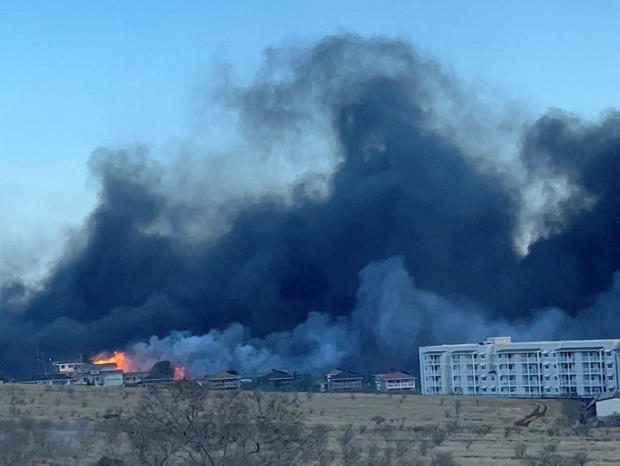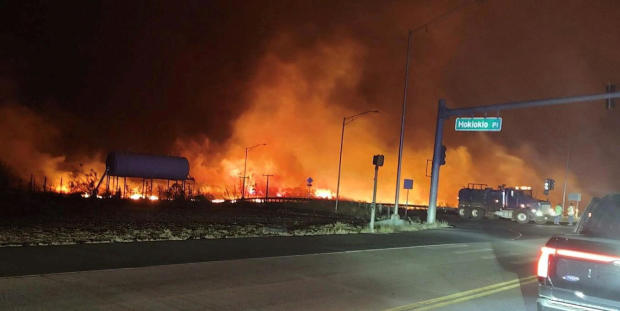How did the Maui fire start? What we know about the cause of the Lahaina blaze
Deadly wildfires burning in Hawaii have forced evacuations and cut power to thousands, fueled by a mix of land and atmospheric conditions that can create "fire weather." A massive blaze destroyed much of the historic town of Lahaina, on Maui, sending some people running into the harbor seeking safety.
At least 36 people were killed in the fires, Maui County said in a statement Wednesday night.
The U.S. Coast Guard said crews had rescued 14 people jumped into the Lahaina harbor in an effort to escape the flames. On Front Street, a popular tourist destination, business owner Alan Dickar described seeing buildings on both sides of the street "engulfed" in flames, in comments to CBS Honolulu affiliate KGMB-TV.
"There were no fire trucks at that point; I think the fire department was overwhelmed," Dickar told the station. Speaking later to CBS News' Patrick Torphy, he added: "Maui can't handle this. ... A lot of people just lost their jobs because a lot of businesses burned. A lot of people lost their homes. ... This is going to be devastating for Maui."
What caused the Maui fire?
Much of Hawaii was under a red flag warning for fire risk when the wildfires broke out, but the exact cause of the blaze is still unknown.
"We don't know what actually ignited the fires, but we were made aware in advance by the National Weather Service that we were in a red flag situation — so that's dry conditions for a long time, so the fuel, the trees and everything, was dry," Maj. Gen. Kenneth Hara, commander general of the Hawaii Army National Guard, said at Wednesday's briefing. That, along with low humidity and high winds, "set the conditions for the wildfires," he said.

The powerful winds fanning the flames were generated by Hurricane Dora, a storm that was moving across the Pacific Ocean hundreds of miles south of the Hawaiian islands, the National Weather Service said.
The hurricane, classified as a Category 4 by the Central Pacific Hurricane Center on Wednesday morning, contributed to heavy wind gusts above 60 miles per hour that tore through Maui, knocking out power lines and damaging homes.
National Guard helicopters activated as part of the state's emergency response to the wildfires were grounded as the wind gusts picked up on Tuesday evening.
Several #wildfires are burning across parts of Hawaii this week, fueled in part by strong winds from Hurricane Dora passing to the south. @NOAA's GOESWest was tracking the hotspots and smoke from the fires as they burned across parts of Maui and the Big Island yesterday evening.… pic.twitter.com/WzApS2ddTi
— NOAA Satellites (@NOAASatellites) August 9, 2023
Acting Hawaii Gov. Sylvia Luke issued an emergency proclamation Tuesday authorizing the deployment of National Guard troops, and extended the state of emergency on Wednesday. She discouraged "non-essential air travel to Maui."
While well to the south of the Hawaiian Islands, Hurricane Dora is creating strong winds across the Islands which are creating dangerous fire conditions. https://t.co/12ut6VYhbx
— National Weather Service (@NWS) August 9, 2023
The National Weather Service noted in tweet Sunday that significant differences in atmospheric pressure between the hurricane and the air north of Hawaii formed a pressure gradient over the islands which, when combined with dry conditions, posed a serious threat of fires as well as damaging winds.
"While Hurricane Dora passes well south with no direct impacts here, the strong pressure gradient between it & the high pressure to the north creates a threat of damaging winds & fire weather (due to ongoing dry conditions) from early Mon to Wed," the agency said at the time.
How do wildfires usually start?
Almost 85% of wildfires in the United States are caused by humans, according to the National Park Service. Fires that are sparked this way can result accidentally from leaving campfires unattended, burning debris, using various kinds of equipment and discarding cigarettes improperly. Intentional acts of arson are another source of human-caused wildfires, the agency says.
Lightning and volcanic activity are two natural causes of wildfires, although officials note that lightning strikes are a much more common catalyst.
Certain weather can ignite and help spread fires, with strong winds, low relative humidity, unstable atmospheric conditions and thunderstorms contributing to what meteorologists call "fire weather," said Nick Nauslar, a meteorologist and former weather forecaster at the National Oceanic and Atmospheric Administration's Storm Prediction Center, in a 2018 FAQ published by the agency.
Most often, lightning strikes a tree and ignites a fire, but strong winds can also spark power lines that go on to ignite wildfires when there is dry brush or grass in the area, according to NOAA, which says wildfires can spread quickly in hot, dry and windy conditions — especially when those conditions happen simultaneously. The wildfire season has been severe in Canada and across North America this year, as warm and dry conditions persist while various sections of the continent experience record heat and drought as a result of climate change.

Maui Fire officials warned this week that "erratic wind, challenging terrain, steep slopes and dropping humidity, the direction and the location of the fire conditions make it difficult to predict path and speed of a wildfire," in an alert issued Tuesday by county officials. It noted that "fires can start at a far distance from their source" when wind pushes embers upward and sparks are ignited downwind.
"The fire can be a mile or more from your house, but in a minute or two, it can be at your house," said Fire Assistant Chief Jeff Giesea in a statement included in the alert. "Burning airborne materials can light fires a great distance away from the main body of fire."
Where are the fires in Maui?
Fire was already widespread Tuesday night in Lahaina, which is in West Maui, the County of Maui tweeted, notifying people of road closures in the area. It was also affecting Kula, an inland Upcountry section of the island, on Wednesday. Crews were battling both brush fires and structure fires in West Maui and in Upcountry areas late Tuesday as people evacuated, the county said.
- In:
- Fire
Disclaimer: The copyright of this article belongs to the original author. Reposting this article is solely for the purpose of information dissemination and does not constitute any investment advice. If there is any infringement, please contact us immediately. We will make corrections or deletions as necessary. Thank you.



